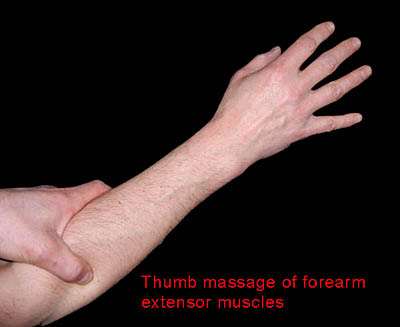(Article updated 22 April 2011)
RSI symptoms are very often the result of extremely tight (overused) forearm extensor muscles. These muscles are located in the upper forearm region. They are used to raise the wrist and fingers, which is the primary motion involved in unergonomic keyboard and mouse driven activities such as having the hands bend backwards and fingers raised while hovering over a keyboard ready to type.
The tight and potentially knotted extensor muscles end up being over used, and don’t get the chance to recover. This leaves them in a permanently fatigued state, tightly tensioning the forearm tendons to which the extensor muscles are attached, causing referred pain down the tight tendons into the hands, wrist and fingers.

The forearm extensor muscles consist of five main muscles and are shown colour coded in their approximate position in the image above. The image is meant for indication only, and I recommend you search for a more detailed anatomical diagram for a more accurate placement.
The five forearm extensor muscles are –
- Extensor carpus radialis longus which attaches to the index finger but controls bending of the wrist towards the thumb as well as bending the wrist back.
- Extensor carpi radialis brevis which attaches to the middle finger and again controls the raising of the wrist.
- Extensor digitorum which attaches to all four fingers of the hand but controls the straightening of the 3rd, 4th, 5th fingers.
- Extensor carpi ulnarus which attaches to the 5th finger and is used to cock the wrist outwards, for example reaching for a far away key on a keyboard.
- Extensor indicis attaches from not far behind the wrist to the index finger and is the primary control muscle of that finger.
The extensor muscles exist at different depths in the arm and some are hard to precisely locate.
Over use strains along any of these extensor muscles from bad ergonomic practices (like having a clawed wrist at a keyboard) can lead to them developing knots (solid tissue that is scarred). This scarring results in pain (to press on at the location of the knots) but is mainly noticeable as referred pain down the forearms into the back of the hands and fingers – which is a classic RSI symptom. The extensor muscles (apart from the extensor indicis) attach to various bones around the elbow joint, and some pain symptoms can also be found close in to the attachment points.
You can do a check to see how fatigued your forearm extensor muscles are. Using your left hand to check your right forearm extensor muscles press down firmly with the thumb onto the full area of the various forearm extensor muscles, move the position of the thumb over these muscles and check for pain. Repeat the diagnosis with the left arm extensor muscles and your right thumb.

If you are in any doubt about what these muscles do, press your thumb on your arm as above and raise your wrist up as if you were about to type. Also raise and wiggle your fingers. With your thumb, you should be able to feel the various extensor muscles tightening as your wrist and fingers raise.
If you find the extensor muscles to be in pain with the above procedure then these muscles are fatigued. It also means that ergonomically, you are not using your keyboard properly and are probably typing using the claw, which causes this type of problem. This type of condition is one of the most common mechanisms for RSI pain, but can easily be addressed by changing the way you type.
If you are experiencing pain in these muscles, it is time to try to relieve them which can be done by massage, icing and rest. Consult your doctor or a trained physiotherapist to find out the best techniques which may include ultrasound. You should also read my post about Trigger Point Therapy on extensor forearm muscles which describes my findings from an excellent book for self help in RSI diagnosis and massage techniques. You may also want to try to find a knowledgeable Trigger Point massage therapist.
It is also time to re-assess your typing technique otherwise you may be placing yourself at risk of an RSI type condition. This may send the forearm extensor muscles into a more permanently fatigued state, from which recovery may be difficult, and in some extreme cases may be impossible.
In my own case, forearm muscle fatigue is the primary mechanism for my RSI pain. Unfortunately for me, I learned of the prevention techniques several years after my symptoms began, when these symptoms had already become more persistent. I do however still get some much needed temporary pain relief these days from massage of the forearm extensor muscles and tendons, just not very long lasting , but my injury is after all a long term one.
Related articles on forearm extensor muscles :
Forearm extensor muscle overuse wrist position and RSI
Does forearm extensor trigger point massage offerer a potential cure for RSI?
Rate this post! [ratings]
 The rate of success in dealing with RSI symptoms is proportional to the speed that a sufferer can diagnose the causes of those symptoms, and their understanding of the corrective actions required to avoid further injury.
The rate of success in dealing with RSI symptoms is proportional to the speed that a sufferer can diagnose the causes of those symptoms, and their understanding of the corrective actions required to avoid further injury.